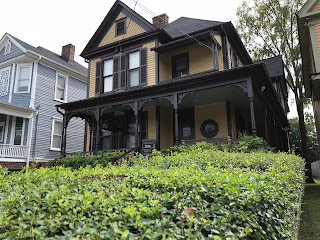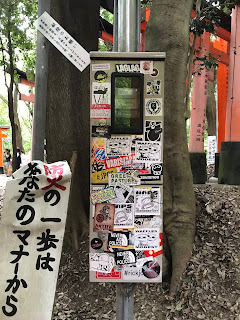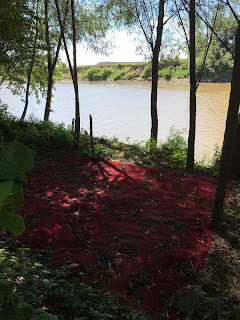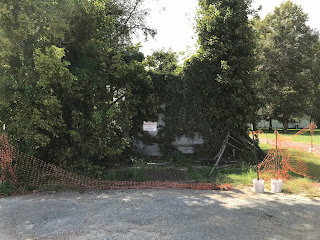At this point in my sabbatical, I've traveled to one international destination (Japan), five U.S. states, visited 16 cities, several important museums and many sites that have a crucial (for some, even sacred) value in the struggle for human and civil rights. I sincerely appreciate everyone who has read my travel blog and given me praise and/or constructive feedback so far.
Now on to Montgomery and Selma, Alabama.
I'm continually fascinated by the unique events that finally inspire change but I also realize such pivotal moments, like Rosa Parks refusing to give up her seat, might have never happened without the many struggles for justice and equality leading up to it. Mrs. Parks was not alone in her actions.
Many other people disobeyed the unjust busing laws in Montgomery and other places, like Pauli Murray, Mary Louise Smith and
Claudette Colvin, or
defied racism in
their own way. Their bravery is just as important to the history of civil rights.
Take a moment to look at this Google Map image of downtown Montgomery.
The
Rosa Parks Museum, run by Troy University, is located on the spot where Mrs. Parks was arrested (image below). This interactive museum stands on the site of the old
Empire Theater. One of the museum workers told me she was extremely sad to see the theater torn down. She said it would have been nice to at least have kept the outside of the building intact and renovated the inside for the museum.
The spot where Mrs. Parks got on the bus (images below) is a few blocks away, on Dexter Avenue, which runs through downtown Montgomery to the Alabama State Capitol building.
The bus stop marker is located under the trees, to the right of Court Square fountain, another historical location from Montgomery's troubled past.
As you look east on Dexter Ave., past the Rosa Parks bus stop and fountain (images above), you see the Alabama State Capitol building. Just before you reach the Capitol, on the right (or south side of the street), you will find the
Dexter Avenue Baptist Church (image below), where King preached and held meetings to discuss the bus boycott.
I admit, I had no idea
this house was in Montgomery until one of the workers at the Rosa Parks museum mentioned it as a place to see while I was in town. I'd only known about the
Confederate White House in Richmond, VA up to this point so I was very surprised to find out about this other historic location. I talked with Dr. Bob Weiland, Curator and Supervisor, and Receptionist Evelyn England about why the Confederacy moved their Capital to Richmond after only a few months. I was told about a few reasons but the biggest one was it was too hot in Montgomery.
The house is filled with portraits of Jefferson Davis and his family, along with their personal items and objects used by some famous Confederate Generals.

After my visit to the Confederate White House, I walked to the nearby
Southern Poverty Law Center (SPLC) building to see their museum exhibits and the
Civil Rights Memorial designed by
Maya Lin. Located on the front side of the building, the memorial
honors the martyrs of this monumental struggle. Once I finished with the exhibits, I struck up a conversation with two staff members about several issues, including going to Selma. They told me
not to make the short forty-five minute drive because they had recently read a few stories about the city being a bit dangerous for tourists.
While I certainly respected their warnings, I decided to go to Selma anyway and had no problems at all. In fact, NPS Ranger April Baldwin, who works at the Selma Interpretive History Center, was surprised to hear this and assured me there are no problems with tourists being hassled or put in danger while in Selma.
Selma holds an incredibly special place in our civil rights history. However, just as I said above, there is usually a preceding story of struggle. The February 18, 1965
murder of Jimmie Lee Jackson during a peaceful voting rights protest in Marion, Alabama, is considered the inspiration for the later marches
from Selma to Montgomery. As he tried to protect his mother from police brutality, he was shot by another officer who thought Jimmie Lee was armed. In response, a protest for voting rights was organized in early March 1965, led by John Lewis and the
Rev. Hosea Williams. The nonviolent march over the
Edmund Pettus Bridge was met with deadly force in what became known as "Bloody Sunday". Here's a Los Angeles Times video story on
the first march as well as a
short film about the march made in 1965 by the filmmaker Stefan Sharff.



I felt a strange but meaningful connection between what I saw in Montgomery and Selma and my experience at Dr. King's birth home in Atlanta. (Reminder - I was asked by a black woman why, as a white man, I thought it was important to visit King's house). I had asked Dr. Weiland about the diversity of visitors to the Confederate White House. His gracious first answer covered the various nationalities that visit the house but when further pressed about a different kind of diversity, namely black visitors, he told me they are only about 5% of the annual visitor traffic. Why would any black person visit this monument to the Confederacy? Unfortunately, I did not have the opportunity to ask anyone in the house because the only other visitors present were a white family.
During my conversation with the two SPLC staff members, we also talked about the Confederate White House, who visits it and why. These two women, who happen to be black, stated they would never set foot in the Confederate White House because of what it stands for and how, from their perspective, it ignores the brutal history of slavery and segregation. For his part, Dr. Weiland told me he is always ready to engage visitors in conversation about these topics.
Maybe the answer to this question is that obvious and I didn't need to hear it from a black visitor while they were with me in the house. However, I paused and took the time to work past my initial answer/reaction to consider the deeper set of complexities and hard realities calling for my thoughtful attention. What those complexities and hard realities are is up to all of us to figure out. Start with putting yourself in spaces where you are challenged to think differently and deeper about everything you think you know.
For example...The Alabama State Capitol grounds have a few Confederate reminders, mostly memorials and statues of individuals like Jefferson Davis and Dr. James Marion Sims. However, neither the Capitol grounds nor the link above provide the reader with a more complete history for either person. Compare the information in the above link with
another perspective on Dr. Sims and then maybe consider why this particular person's history has been told from these different perspectives.
In many places throughout this country, stories about our racial history have been told from a very selective, dominant perspective. For example, I often hear the assertion that the Confederate flag and interrelated Civil War memorials are part of our history and must be allowed to have their own space. I agree, such things are part of our history but therein lies the problem - it is an incomplete history. One side of the story has dominated many of our public spaces. I was told by NPS Ranger April Baldwin that because only one side of the story has been told, places like Montgomery and Selma are still highly divided cities, the difference being laws no longer enforce it.
Most thoughtful people understand that trying to navigate the complexities and hard realities of our history is arduous and brings with it lots of conflict. How do we get to a place and time where the whole history can be told? The weight of shame, blame and guilt surrounding this history seems at times unmovable but with serious effort, perhaps it can be managed and healed. I'm reminded of my experience in Sumner, Mississippi, and the story of the man who wanted to rip out the Emmett Till court trial historic marker, saying we need to stop bringing up that part of our history, all while being just steps away from yet another Civil War memorial. He was able to figure out an answer. This complex history sits patiently in the middle of our divisions, waiting and relying on thoughtful people to create common ground solutions.
These experiences and conversations brought to mind the
MLK Memorial in Washington D.C., the symbolism of how it is physically positioned and of the quote written on it, "Out of the mountain of despair, a stone of hope". The center portion, with the grand sculpture of MLK, has been moved forward and pushed to the side by a mighty force - millions of determined people who worked to help our country live up to its founding documents. The mountain of racism wasn't completely ended, but a "stone of hope" was created, giving more people the opportunity for equity and justice.
The image below may illustrate what I mean. From time to time I work in D.C. as a licensed tour guide. My groups are all school-aged students. After telling them about this history, I encourage them to stand shoulder to shoulder, link arms or hold hands and walk through the memorial, all while remembering and being mindful of those who cleared the path for all of us to do so. Here you can see a few kids from one of my groups walking hand in hand through the memorial.
And now I'm ready to be challenged on everything I just wrote. Over the years, I've learned how to stay with the discomfort that comes from being shortsighted in my observations or just plain wrong on a topic. As a result, I'm also willing to adjust, and to rethink everything above, hopefully with people who are even more educated. I'm more interested in being well informed and ready to act in ways that help myself and others through these complexities and hard realities.



























































